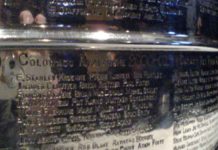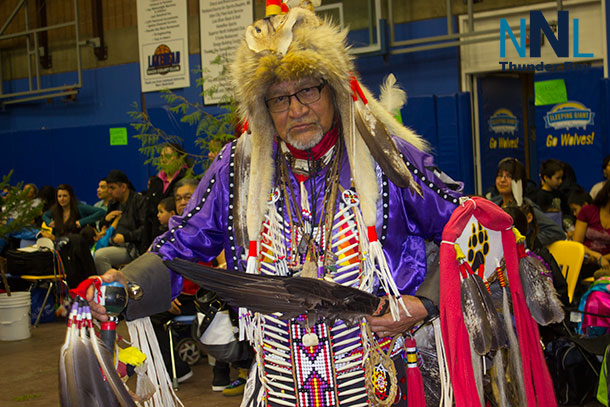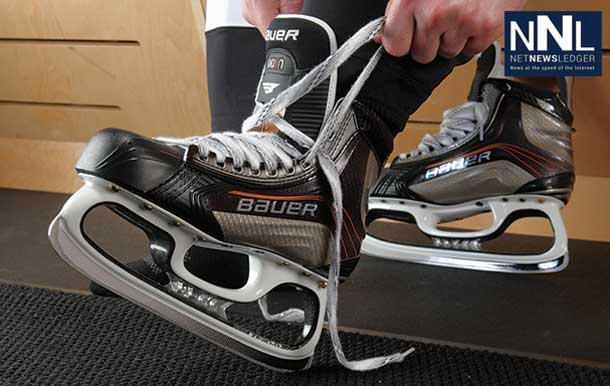
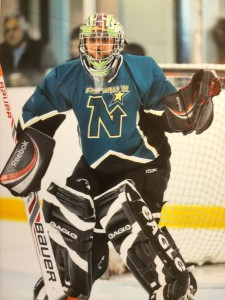
THUNDER BAY – Toronto’s Pearson International Airport is near the centre of a massive web of human activity that includes multi-laned expressways, most notably among them the often jam-packed spinal column of Toronto, the Highway 401. Westward of Pearson, the 401 highway connects to the 403, which slices the GTA surburb of Mississauga as an L-shaped major artery.
Mississauga is a booming suburb with a population of over 700,000 residents, consisting of box stores, restaurants, subdivisions, hotels, its own downtown core, and…several hockey arenas. In recent years, it has played host to the annual Little NHL Tournament, and in these very hotels and arenas, tens of thousands of First Nations people (the hockey players and their families as well as coaches, trainers, managers, and extended family and siblings), converge to play during the March Break. For this year’s tournament, 177 teams from various First Nations across the province of Ontario have taken part.
My hotel location was located near the Mississaugan-Torontonian border, in Etobicoke, which is only a few kilometres away from the Pearson Airport. I did manage to get a few early morning long-distance runs in while there: I crossed streets like Kipling, Islington, and Royal York, all the way down to the Humber Valley, running alongside the Humber River on Scarlett Road, and then all the way back again pretty much uphill, via Eglinton Avenue.
Etobicoke neighbourhoods and minor hockey bring to mind a legendary Canadian icon of hockey, who grew up in this area and played his minor hockey years as what he calls, “Just a Humber Valley goalie”: Ken Dryden, the goalie child whose father had their backyard paved with asphalt, so that Ken and his brother Dave (who was 6 years his senior, and also a goalie) could host backyard games to play along with the other local children. The father’s strategy worked out: thanks to the consistent practice, both Dryden boys ended up playing in the NHL (Dave with the Buffalo Sabres, and Ken with his famed career as goaltender for the glorious Montreal Canadiens of the 1970’s).
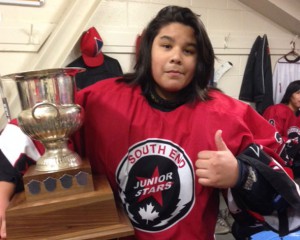
Breathing in the early morning Etobicoke air, the trees in the still-dark valley allowing glimpses of the oncoming sunrise (bii-dah-bun, in Anishnawbemowin) through a purpled sky, led me to ponder why a very young hockey player would want to play such a position at all in the first place. This Humber River valley produced a winner, one of the best in the game. Exceptional reflexes and most important, calm under pressure and unwillingness to give up, even after being pounded upon by the opposition. Goalies can be a tough lot.
However, there are so many downsides. First of all, a goalie’s mistake is often the one that may end up on the scoreboard. It may not though, yet there is that risk.
Often, a goal may be the result of a team’s poor defensive zone coverage on the part of its defensemen, and also on the part of the forwards who are supposed to be assisting those defensemen by back-checking – “whose man was that who scored? The centre’s? The left winger’s?”, but there are other times when a goalie can make an individual slip and single-handedly alter the score of a game. Goalies do play with the stress of that risk. Why would anyone want to?
After a good win, teammates may congratulate their goaltender on a job well done, while after a bitter loss…it is traditional for teammates to thank their goaltender regardless of the score, but sometimes there may be a feeling of blame on the goalie there from some, including parents in the stands.
Sometimes not. Hockey is a team sport, and most children do understand this, standing by their goalie no matter what the outcome. But why would any child want to shoulder the stress of this burden?
Yes, hockey is a team sport and just as a team should win as a team, and it should also lose as a team. No individual player should shoulder that burden. A win or a loss is a reflection of how the team as a whole has played. Yet, there the goalies are in the back…taking the brunt of anything that anyone throws at them, physically as well as any other way. Such a courageous stand, both mentally and emotionally as well as physically.
As many have described, goalies can be a different breed of hockey player. They are rare. They survive through grit and determination, mental toughness and concentration, sometimes against all odds. They are the last line of the team’s defense. In a way, the resiliency and the battles that they must endure are reminiscent of the struggle of First Nations people under colonization.
Why would a young child want to subject themselves to this? A First Nations child? Is it because they are good at facing challenges head on? What happens when you combine: a very young person, a First Nations child, as a goaltender, playing in the pressure-packed situation of playing in a Little NHL Tournament in Mississauga?
I wanted to explore this firsthand for the reader, as the topic of minor hockey goalies is not often discussed for the public. At the Little NHL Tournament, I am fortunate to have the chance to see a few such young First Nations youth participate under very stressful situations. I also observe my own son, Anawtyn Rasevych, regularly (he is a Ginoogaming First Nation member and plays as a Peewee, ages 11-12) as I also coach him. I was able to sit down and chat with a few of these inspiring young First Nations warriors.
Leona Scanlon of Thunder Bay paces in the concession area of the Hershey Centre Arena in Mississauga. I am able to spot her right away as I walk in the front doors. No hot dog or coffee in her hands. Would she be able to stomach it? Just that look of a goalie parent who is mentally preparing for the game. Her son, Neebin Wabasse (a Webequie First Nation member), is playing here for the Fort William First Nation North Stars Midget team (ages 15-17). Leona’s mind is clearly already in her son’s goal crease, even though the game is not set to start for a little while yet. The life of a goalie parent.
Neebin’s path to goaltending has been an interesting one. He did not take up the position until his second year of Bantam (ages 13-14) hockey. His development though, has been phenomenal. Parental support goes a long way. What drew him to it? It is easy to see when one watches him play: he is confident, agile, and smooth in his movements. His favourite NHL netminder, he says: “Marc-Andre Fleury.” His all-time favourite: “Ron Hextall.” Leona functions as his personal trainer/goalie coach/equipment manager/counsellor, as many goalie parents end up doing. There are coaches of course on any hockey team, but it is a stroke of luck if one ends up on a team that has a goalie coach volunteering. With such support, Neebin has been able to accelerate the realization of some of his hockey aspirations.
He is calm, quiet, and relaxed, which may not be the case for all goaltenders, but I am seeing that it is definitely a commonality among them. Meditative almost. Why? Because goaltending can be a cerebral position. As Ken Dryden’s teammates and other hockey analysts have noted, at times, a goalie may go for several minutes without receiving any action at all. But then, suddenly, the floodgates may erupt as opposing players assault their space and a flurry of ferocious activity will be hurricane-like around the goalie, threatening their physical safety even and causing havoc on them. Face the onslaught head-on, and make your stand no matter what. Then, it is gone…for the time being, until the next wave of fierce opposition attack. A goalie therefore needs to be mentally “in” the game at all games, whether they are busy or not. Credit the goalie’s ability to maintain concentration, and not let their mind wander away somewhere during the times that they are not busy.
Like most other teenagers, Neebin is focused on his xbox and his schooling, in addition to his work with the South End Junior Stars in Thunder Bay (his Midget team) as well as the Fort William First Nation North Stars here at the Little NHL Tournament.
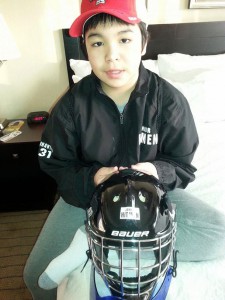
Anawtyn Rasevych is a similar personality: reserved and pensive. Calm on the ice…and yes, very much liking his xbox. He is here playing for the Long Lake #58 First Nation Hitmen Peewee (ages 11-12) team.
He also plays for the Longlac Timberwolves Peewee team in the Longlac Minor Hockey Association, after having begun his goaltending duties at the age of 8 while registered in the Current River Mighty Mites hockey program in Thunder Bay.
He began full-time goaltending duties in Thunder Bay at the Atom (age 9-10) level while on a Westfort Rangers team.
Why?
I like to stop the shooters.”
Therein lies some of the passion, but…what is the best part of goaltending? “It feels good to make a big save, and to come through for your teammates.”
I begin to uncover that goalies are true team players. They put themselves out there at great risk for their teammates, and Anawtyn is certainly a team guy.
This is not Anawtyn’s first Little NHL Tournament; he is a veteran warrior.
He usually plays for his home community, the Ginoogaming First Nation Winterhawks, when they come to Mississauga. But this year, in a display of inter-community partnership and dedication to the children, Ginoogaming’s sister community a mile away, across the lake (Long Lake #58 First Nation) organized for the older children (Peewee and Midget teams) while Ginoogaming worked for the younger children (Tyke, Novice, and Atom teams). Both communities picked up each other’s players. Anawtyn’s friends and relatives are from both bands.
What is the worst part about goaltending? According to Anawtyn, “When your own teammates shoot at you while your back is turned.” Duly noted. In practices or pre-game warmups, teammates may get a bit too revved up on adrenaline, and not respect a goalie’s efforts to get themselves into a game. Before a game, a goalie is attempting as best they can to enter a zen-like state of concentration, within their own inner sanctum. It does not help at all when their own teammates disrupt this by blasting slap shots around their ears, or even at their backs.
As Anawtyn proposes, goalies need to be respected before games and during practices, so that they can gain focus to play at their best. Pre-game warmup is for the goalie’s benefit: light wrist shots that glance off of the goalie’s pads, to get them a feel for the puck before a game, are what work best. Frazzling a goalie’s nerves a few minutes before the game starts does nothing at all to help the team. Much of a goalie’s job is mental…like trying to concentrate on lane changes on the 401. One cannot accomplish it with distractions.
Favourite NHL goaltender? Carey Price. Of course, the reasoning being that he is a First Nations person…and is renowned for being calm and cool under pressure. Anawtyn then lifts his pant leg to show me the skin near his knees, which is gouge-marked as a result of opposing forwards brutally “digging on” him with the blades of their sticks while he was down in the crease after having made an important save, during that morning’s game. Goalies certainly must rely on their teammates to back them up, and that is another important aspect of this team game. Jarome Meshake, one of Anawtyn’s defensemen, received a two-minute penalty for physically moving the opposing player away from Anawtyn, and this illustrates that part of the reality that a goaltender must face: they are in a prone position after having made a save and are susceptible to injury. They sacrifice themselves for the team.
Very much like Neebin, Anawtyn is extremely focused while engaged in his xbox activities. Assists with developing hand-eye coordination? Yeah, okay.
Heather Semple is the same age as Anawtyn (11 years old), and is a Kasabonika Lake First Nation member. She is here at the Little NHL Tournament playing for the Fort William First Nation North Stars (Girls) Peewee team. She obviously has taken a different path, playing in her first year as a goaltender for the Thunder Bay Tigers of the Thunder Bay Women’s Hockey Association (TBWHA). Most notably…this is Heather’s first year playing organized hockey! Incredible.
Participating in tournaments over the past season has greatly assisted her development: Dryden, Minnesota, Little Band Tournament in Sioux Lookout, and now Little NHL in Mississauga. Her ever-supportive father, Titus Semple, notes that “gaining confidence is the key.” He is correct. A goalie cannot play the position if they do not have confidence in themselves or in their abilities. It is impossible.
The worst thing for anyone to do, would be to tell a goalie that they cannot perform adequately at the position, or to doubt a goalie’s abilities. The balloon of confidence must be inflated, not deflated. Confidence is that mental quality, that immaterial essence that is more precious to a developing goalie than gold. Heather has built and gained confidence as this recent year has progressed. As Titus notes, the confidence carries forward off of the ice too.
Titus also notes that the goaltending position may be overlooked by many children and parents, “due to the fact that there are additional costs for equipment, but there are always second-hand options available.” Indeed, the stuff actually can be better at times, because it is already broken in. It can be very affordable. There are always goalies out there outgrowing their current equipment, so there is always equipment available.
Why did Heather take up goaltending? “I enjoyed it much better than being a player.” Fun is also another key that is often overlooked by many.
What is the worst part of goaltending? “When the other team gets a breakaway. You don’t know if they will score or not. And that can be scary…” Breakaways result when a team’s defenses have broken down, and the opposing team moves in on the goalie unopposed. Goalies need support. But they do their jobs diligently and faithfully, regardless of what the situation.
Interestingly, Heather responds exactly the same way that Anawtyn did, when asked what the best part of goaltending is: “Making the big saves, and having your teammates support and congratulate you for making a good save.”
Therein lies the answer, let the veil of mystery be lifted. This is a big part of the reason why goalies do what they do. Despite the fact that they may at times appear quiet, even disconnected, from their teammates either on the ice or off of it…goalies are true team players. Accepting the physical risks (facing 40-80 mile per hour slap shots, which could easily maim them), the emotional stresses that result from burdens placed on them, all have to do with that desire to be a team player.
They are not individualistic, even though they are out there in their own worlds, separate from everyone else while on the ice.
Goalie parents are often the same. Leona sits in the stands, feeling every shot that Neebin must take. Titus stands at the glass next to the boards, intent on facing whatever Heather must face as if he himself is playing. Who can understand goalies and goalie parents? Other goalies and other goalie parents.
The traffic on the 401 is running smoothly, the Hershey Centre and the other Mississauga hockey arenas are bustling, and it is time for another year of young First Nations goalie memories to be made. The spirit of Ken Dryden and his courageous stands in the 1970’s stand tall and are an inspiration, as the sun rises over the Humber Valley…on these young goalies who are team warriors in the truest sense of the word.
Peter Rasevych



